


Soul Sacrifice is a very good game, but there’s a learning curve that every budding magician must navigate if they are to succeed in the twisted adventure. With the morally dense title now ripping up store shelves, we’ve wrapped ourselves in our favourite raiment in order to bring you some beginner’s tips for the PlayStation Vita exclusive.

Soul Sacrifice is dark fantasy adventure loosely inspired by the Monster Hunter games. Upon starting the title you’ll encounter Librom, a talking novel who will encourage you to create a new character. Don’t worry too much at this stage, because everything that you settle upon can be changed at a later date in exchange for Lacrima, a teardrop currency which we’ll discuss in more detail shortly.
The core gameplay sees you transported to different arenas, casting spells in order to dispatch a variety of ghoulish foes. You can carry six offerings (or spells) with you at any given time, with three mapped to the Square, Triangle, and Circle buttons. Tapping the right trigger will toggle your loadout, allowing you to access your remaining three spells. You can sprint by holding X, and dodge by hitting the button while pushing the left analogue in a specific direction. Pressing X while you’re stood still will prompt your character to whistle, while pushing down on the d-pad will activate Mind’s Eye, a detective state which highlights points of interest in the world and also shows the health of both allies and enemies.
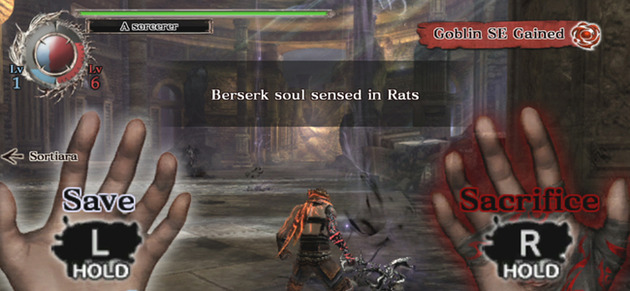
It’s up to you. Soul Sacrifice is supposed to make you think, but there are advantages to being good and bad in different situations. Saving an enemy’s life will reward you with health, which can come in handy when you’re in the midst of a challenging battle. This will also increase your overall Life meter, which will enhance your defence and recovery statistics when levelled up. Conversely, sacrificing an enemy’s life will replenish your offerings, while raising your Magic meter. When levelled up, this will increase your offensive potency.
You can choose to level up both meters as you please, but there are consequences to specialising in one or the other. However, don’t worry if you change your mind during the course of the adventure, as you can respec your character at any time in exchange for Lacrima.
Saving or sacrificing allies (either computer-controlled or online) has a slightly different impact. You’ll need to surrender your own health in order to bring an assistant back from the brink, while sacrificing a friend will issue a devastating magical attack that will damage all of the foes currently on the screen. These affect your overall Life and Magic meters in exactly the same way. However, if you sacrifice a computer-controlled counterpart, you’ll need to spend Lacrima in order to bring them back to life.
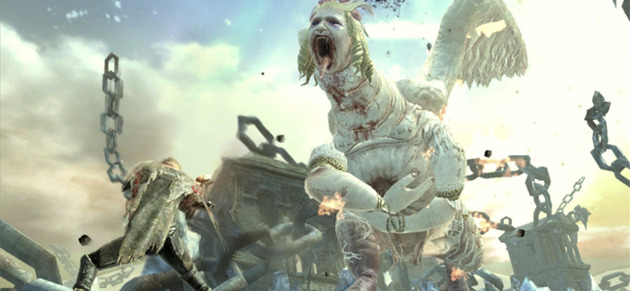
Offerings are the spells that you’ll use in Soul Sacrifice. These can be collected by completing quests in the game, and can be arranged in the Portraiture portion of Librom. You can assign six spells to a single loadout, as well as record specific sets so that they can be recalled at any time.
Each spell has a usage quota, which is consumed each time that it is used in battle. If you exceed this limit, then you’ll temporarily lose access to the spell until you renew it using Lacrima. In order to ensure that you don’t exceed your tally in battle, you’ll need to sacrifice souls to renew your offerings. Alternatively, you can search for enchanted objects in the environment – demonstrated by white auras in Mind’s Eye mode – which will replenish your offerings.
To increase the number of times that you use a spell, you’ll need to merge two of the same type together. This will upgrade the selected offering, but keep in mind that you may need to grind specific quests or fuse multiple items together in order to collect the hexes that you need.
Fusing can be accessed by tapping the L trigger in the offerings screen. Here you’ll be able to peruse a list of recipes, with various required ingredients included. Experiment with different types of offerings, and remember that there’s no right answer. You can choose to play as a ranged character, a close-quarters brawler, or somewhere in between – it’s entirely up to you.

Sigils are buffs that can be assigned to your right arm. You’ll unlock more of these by collecting Life and Magic souls by saving or sacrificing creatures. You can apply a total of five Sigils to your right arm: one to your palm, two to your forearm, and two to your upper arm. It’s important to select buffs that complement your playstyle. If you use a lot of homing attacks for example, you may want to double down in this area.
Many of the Sigils have a main property, and a secondary enhancement. Some of these will require you to have a specific type of arm in order to reap the rewards. In order to attain a Light arm, you’ll need to spec your character in favour of the Life meter. Meanwhile, a Dark arm will require an emphasis on the Magic meter. Unsurprisingly, you can attain a Neutral arm by sustaining a balance between the two meters.

Lacrima is a mythical correction fluid that’s excreted by Librom. Upon the completion of quests, the novel will implore you to check for droplets. Simply tap the area beneath the book’s eye to acquire the fluid. It’s important that you gather a decent amount of this as it’s used as a currency to undo certain aspects of the tome. For example, if you’ve sacrificed one of your computer controlled allies, you’ll need to invest Lacrima in order to bring him or her back to life. You’ll also need ample amounts of the liquid to reverse the effects of Black Rites.
Other uses of Lacrima include changing your sorcerer’s name, renewing exhausted offerings, and reassigning the levels of your protagonist. Make sure that you’ve always got a large reserve of the liquid, because you never know when you may need it.
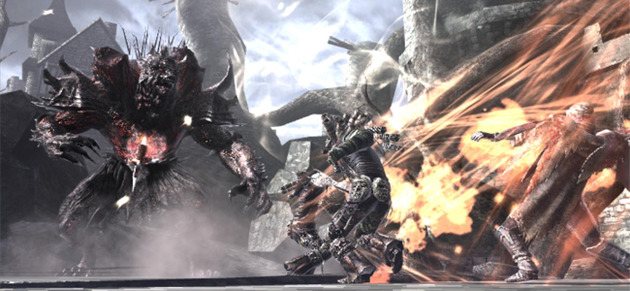
Black Rites are the most powerful and costly spells in Soul Sacrifice. At first, you’ll only have access to Infernus, but you’ll later unlock different types such as Gleipnir. To use a Black Rite, you’ll first need to have been damaged heavily by an enemy or archfiend. Once you’ve soaked up enough damage, an icon will appear in the bottom left corner of the screen indicating that you can use the spell. Touching the virtual button and holding it down will summon the special move, though you will be vulnerable to enemy attacks in the process.
It’s worth remembering that using a Black Rite has repercussions. Infernus, for example, will strip you of your skin, forcing you to fight with diminished defences. The only way to undo this is by spending Lacrima in the Portraiture portion of the novel. Fail to pay the price, and you’ll be forced to fight on while you're severely debilitated. Black Rites, therefore, should be employed as last resorts, or at the very least as part of a pre-planned strategy.
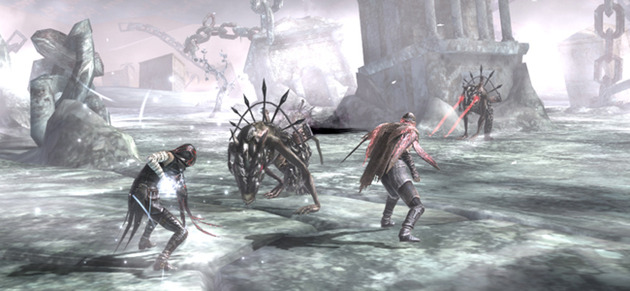
As with most RPGs, many of the spells in Soul Sacrifice have specific properties. These operate in a rock, paper, scissors-esque fashion, with certain attributes working better against different enemy types. You’ll want to pick offerings that do the most damage against the archfiend that you’re facing. While it’s not always immediately clear which group an enemy belongs to, sometimes the quest descriptor will give you a hint. If not, common-sense and trial and error should see you through.
Included above is a list of all of the spell types, and the elements that they work best against.

Soul Sacrifice is a complicated game, but the key is to spend time with it. Its systems may seem impenetrable at first, but persevere and it may just grow on you. Don’t forget to check out our review for a more detailed insight into the game, and remember that you can always download the free demo if you’re not willing to splash out on the title just yet.
Have you got any tips, suggestions, and secrets for Soul Sacrifice? Feel free to share your advice in the comments section below.



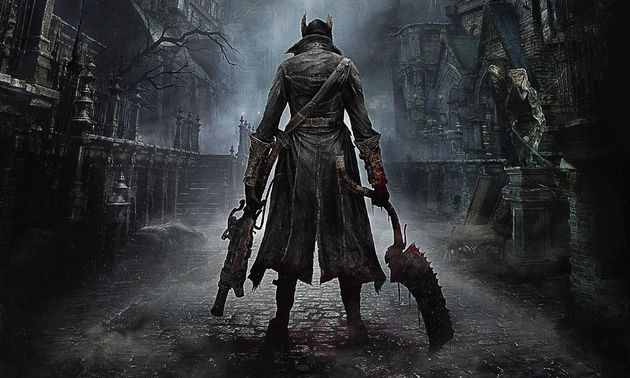
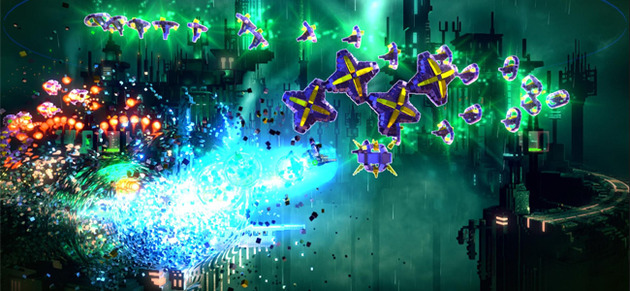 Guide: How to Save the Humans and Stave Off the Keepers in Resogun on PS4
Guide: How to Save the Humans and Stave Off the Keepers in Resogun on PS4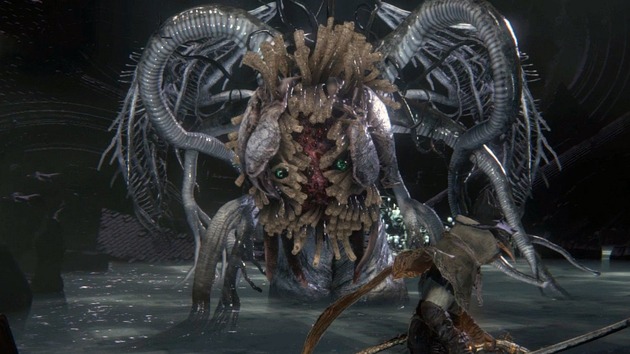 Guide: How to Kill Ebrietas, Daughter of the Cosmos in Bloodborne on PS4
Guide: How to Kill Ebrietas, Daughter of the Cosmos in Bloodborne on PS4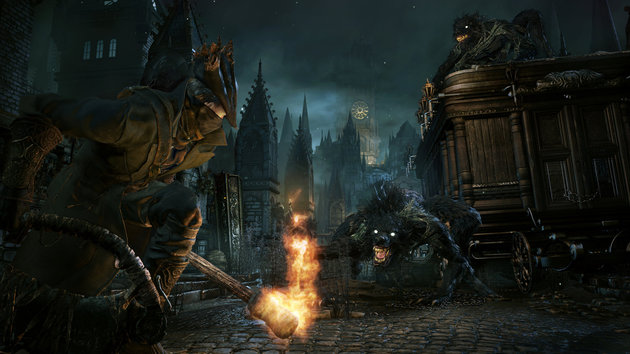 Guide: Pick the Perfect Starting Weapons in Bloodborne on PS4
Guide: Pick the Perfect Starting Weapons in Bloodborne on PS4 Guide: Sneaking to Success in Metal Gear Solid V: The Phantom Pain on PS4
Guide: Sneaking to Success in Metal Gear Solid V: The Phantom Pain on PS4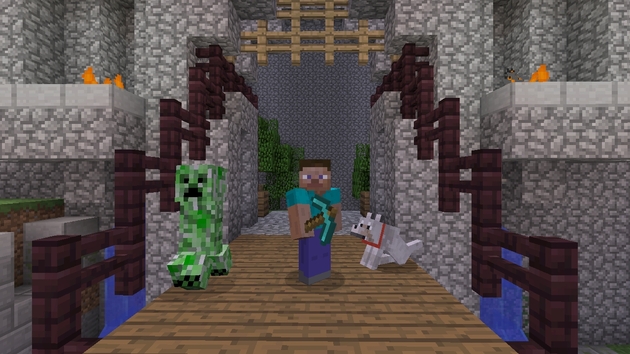 Guide: Minecraft: PlayStation 3 Edition PS3 Trophy Guide & Road Map
Guide: Minecraft: PlayStation 3 Edition PS3 Trophy Guide & Road Map